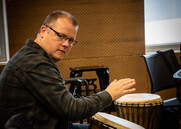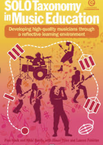|
All the news from Musical Futures International
|
 Luke Peak is Head of Music at Chaffey Secondary College, Mildura and a Musical Futures International Champion. He has been exploring using the SOLO Taxonomy in the Musical Futures classroom and in this article shares some of the ideas and outcomes that have developed across this year. Musical Futures at Chaffey Secondary CollegeChaffey Secondary College has been a Musical Futures Champion School since 2014. The school is located in Mildura, a regional city in north-west Victoria approximately 6 hours’ drive from Melbourne. The classroom music program has grown considerably since I started at the college back in 2011. As a graduate teacher I began working with the Musical Futures approach almost immediately using the Informal Learning model. Students responded positively to learning music in a self-directed and independent way as I encouraged them to work in friendship groups, learning songs of their choice and playing instruments of their choice. As Musical Futures evolved over these years, I was able to incorporate Just Play & Non-Formal Teaching into my Year 7 & 8 classes. In this setting students build functional music skills on a range of instruments through whole class music making using a variety of resources and play-a-longs. Introducing song charts enables a large group of students to begin moving away from the play-a-longs as they develop their musical proficiency and exercise more student voice in song selection and arrangements. As students move into Year 9 and 10 electives, they begin to display more independence as they form friendship groups, choose the music to play and direct their own learning. This is where my role as a teacher shifts from being the musical leader to more of a musical model and resource. Why SOLO Taxonomy?An ongoing challenge has been the formalised tracking of musical progress in a Musical Futures classroom and having reliable formative assessment tools that allow for self-reflection and promote metacognition. As students’ progress through the Musical Futures program they are essentially moving from surface knowledge to deep learning which can be observed as students display greater independence and proficiency over time. As a school we have developed a new instructional model. At its foundation is the implementation of the Visible Learning framework and the use of SOLO taxonomy across all our key learning areas. For those who are not familiar with SOLO taxonomy, it stands for the Structure of Observed Learning Outcomes (SOLO). As a school we have been using SOLO to create differentiated success criteria for our lessons in order to support our learners in moving from surface knowledge to deep learning. Throughout this year I have begun to develop a deeper understanding of how to use the SOLO taxonomy to plan, monitor and evaluate the effect of my teaching on student learning. About SOLO TaxonomyWhen using the SOLO taxonomy in your classroom an important distinction to make is the difference between declarative and functioning knowledge. Declarative knowledge involves knowing about (content based), whereas functioning knowledge is knowing how to (skills/performance based). For the majority of my music classes, the focus is on functioning knowledge. This means that most of my Learning Intentions will start with: To be able to….. Developing SOLO based differentiated success criteria for classes that are dedicated to building musical skills can be used as a way of tracking individual progress over time. SOLO Taxonomy use five hierarchical levels of learning outcome.
 In Term 3 this year I came across the newly published book: Solo Taxonomy in Music Education (Pam Hook & Nikki Booth, with Alison Price & Lauren Fobister) This book has been a great resource for me in developing formative self-assessment rubrics to enable students to identify the progression of their learning outcomes whilst providing me with a reliable tool to track musical progress over time. SOLO rubrics for Musical FuturesThe following SOLO rubrics have been adapted directly from the book mentioned above. What I have found of particular value is how these formative assessment tools compliment and align directly to existing Musical Futures lessons. They provide a clear description of the varying levels of learning outcome and help to promote self-regulation as they show students the progression toward becoming more independent in relation to the learning intention. OutcomesSharing the SOLO taxonomy with students is helping them make more sense of their learning. In regard to the examples provided I would project the self-assessment rubric at the beginning of a lesson and discuss with the class the different levels of SOLO outcomes that a student may experience by the end of the lesson or unit. As a point of reflection at the end of the lesson I would use the self-assessment rubric so they can develop a better awareness of their individual progress.
As I’ve only introduced these SOLO formative assessment tools this term, my aim is to familiarise my students with the taxonomy so that I’m helping them to understand how it works and how it can be applied to their learning in my lessons. Using SOLO to elicit feedback and develop self-regulated learners is certainly something that I feel aligns with the Musical Futures approach. As a school we have done a lot of work and professional learning around effective feedback this year. Feedback should answer the following 3 questions for both the students and teachers:
SOLO then becomes the measure of quality of the outcome of a lesson. As students become more familiar with this process of reflection their self-regulation develops. This means that they begin to become less reliant on the feedback from the teacher as they assess their own learning progress. Using the SOLO taxonomy as a Musical Futures teacher has brought me greater clarity around making the individual learning outcomes more visible for myself and my students. I have spent a lot of time considering the engagement and authenticity of my lessons which is why Musical Futures continues to resonate strongly with me and my students. The SOLO taxonomy model clearly shows how a learner’s performance changes in this environment from someone who is dependent and reliant to one who is independent and self-reliant.
2 Comments
Musical Futures Admin
11/12/2019 06:09:30 pm
We have been asked to share the following comment from Professor John Biggs, a critical friend for the work of Pam Hook with the classroom based use of SOLO referenced by Luke in the article.
Reply
Leave a Reply. |
AuthorWrite something about yourself. No need to be fancy, just an overview. Archives
August 2023
Categories |
